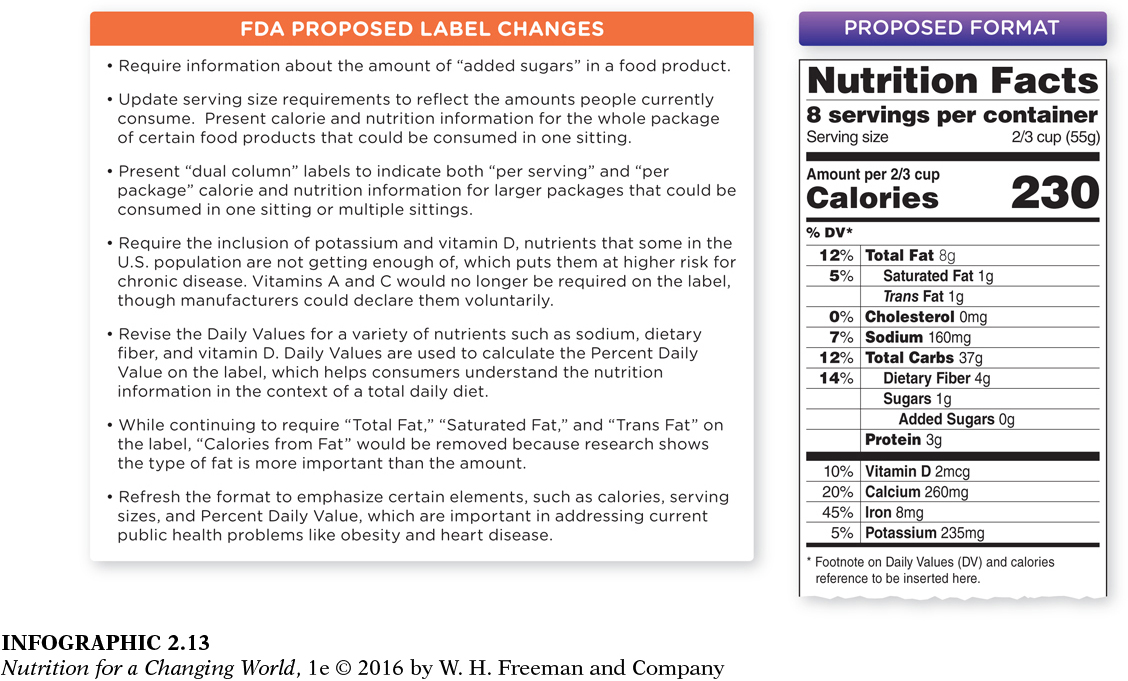FUTURE FOOD LABELS
To address ongoing concerns about food labels, experts are debating ways to revamp labels and make them more useful to the average American. Serving sizes sometimes seem unrealistically small, and people who eat 2 to 3 servings in one sitting may not realize the nutrient values should be multiplied. Some experts have proposed putting calorie and serving size information in larger type at the top of the label, so that it’s immediately clear. In 2014, the FDA issued proposed changes to the Nutrition Facts Panel. (INFOGRAPHIC 2.13)

Question 2.12
 Which nutrients have been added to the food label? Which have been removed?
Which nutrients have been added to the food label? Which have been removed?
The amount of potassium and vitamin D may be required on the new food label, while the amount of vitamins A and C may no longer be required on the label.
In addition to government planning, companies and advocacy groups are experimenting with different ways to present nutrition information and recommendations that they hope will be easier to follow, such as symbols that appear on the front of packages. For instance, the United Kingdom has established a “traffic light” system, where the amount of calories, sugar, fat, saturated fat, and salt are presented on the front of the package in green, yellow, or red according to the healthfulness of the choice. However, manufacturers are not obligated to use the system.
42
In the United States, some grocery stores are displaying the NuVal Nutrition Scoring System, in which a food’s price tag is accompanied by a rating of 1 to 100 based on more than 30 factors, including fiber, phytochemicals, calories, and healthy and unhealthy fats. In other supermarkets, consumers might see Guiding Stars that rate the nutritional quality of food with one to three stars using information from the Nutrition Facts Panel and the ingredients list. As of December of 2015, the government also requires large chain restaurants to list total calorie content for all standard menu items on the menu or menu board. In addition, beginning in December of 2016, the calorie content of foods sold in some vending machines will have to be available to the consumer prior to purchasing the food.
But to Gallagher, none of these tools will help people make better food choices if they don’t have any access to more nutritious options. Since 2006, when results of her first study of Chicago’s food deserts were released, she has helped the city identify six sites that would benefit significantly from a large grocery store. At one of those sites, her data suggest that adding a grocery store would take 24,000 people out of a food desert; people who could potentially collectively gain 13 years of life by avoiding liver disease, 15 years by forestalling diabetes, 58 years by averting diet-related cancer, and more than 100 years by eluding cardiovascular disease. But improving access doesn’t have to be as major a project as building an entirely new store, she says; simply upgrading corner stores by adding fresh foods or establishing mobile grocery stores that travel to neighborhoods in need could make a big difference.
43
In 2010, Walmart hired Gallagher to develop a plan that would entirely eliminate all food deserts from Chicago. That same year, drug-store chain Walgreens announced it would start to sell fruits and vegetables in 10 areas identified as food deserts. Thanks to the increase in access, since 2006 food deserts are affecting approximately 250,000 fewer people. “In the next 10 or 15 years, I see the problem of food deserts being solved. But we’ll still be dealing with the other issues that drive unhealthy habits.”
That’s because access is not the “silver bullet” to get people to make healthy choices and lose weight, she says; just building grocery stores where there are none will not solve all the country’s nutrition woes. So she and her colleagues are conducting experiments to find ways to encourage shoppers to make healthy choices, such as providing selection information for food products, or changing the placement of nutritious food in grocery stores.
If policymakers don’t address the problem of food deserts, they can’t expect people to follow their dietary advice, says Gallagher. “It is disingenuous to preach ‘follow the food pyramid’ or ‘eat your fruits and vegetables’ if you don’t provide access to those foods.”
44